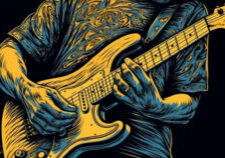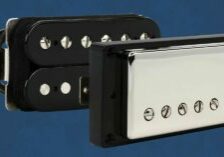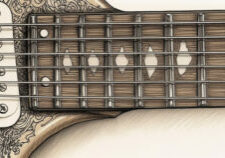This guide will provide beginners with the basic steps on how to use a slide on an electric guitar. A slide is a tool used by guitarists to create unique sounds and add texture to their playing. It can be intimidating for beginners, but with practice and patience, anyone can learn how to use a slide effectively.
Slide Techniques for Electric Guitar Beginners
Playing the electric guitar is a fun and rewarding experience, but it can also be challenging for beginners. One technique that can add a unique sound to your playing is using a slide. A slide is a small tube or cylinder that fits over one of your fingers and allows you to glide along the strings, creating a smooth and distinctive sound. In this article, we will provide some tips and techniques for using a slide on electric guitar.
First, it’s important to choose the right type of slide for your playing style. There are several materials to choose from, including glass, metal, ceramic, and plastic. Each material has its own unique tone and feel. Glass slides are known for their warm tone and smooth gliding action, while metal slides produce a brighter sound with more sustain. Ceramic slides offer a balanced tone with good sustain, while plastic slides are lightweight and easy to use.
Once you have chosen your slide, it’s time to start practicing. The first step is to find the right finger to wear the slide on. Most players prefer to use their ring finger or pinky finger as they allow for greater control over the strings. However, some players may find it more comfortable to use their middle finger or index finger.
Next, you need to position the slide correctly on your finger. We’ll cover this more in detail later in this article. Lastly, we’ll cover tips, tunings and techniques for mastering slide playing.
Choosing the Right Slide for Your Electric Guitar
If you’re new to playing slide on electric guitar, one of the first things you’ll need to do is choose the right slide. There are a few factors to consider when making your selection, including material, size, and weight.
Material
Slides can be made from a variety of materials, each with its own unique sound and feel. Some common options include glass, metal, ceramic, and plastic.
Glass slides are popular for their smooth tone and easy gliding action. They’re also relatively lightweight, which can make them easier to control.
Metal slides tend to have a brighter tone than glass slides and can produce more sustain. However, they can be heavier and more difficult to maneuver.
Ceramic slides offer a warm tone that’s similar to glass but with a bit more bite. They’re also quite durable and resistant to wear.
Plastic slides are often the most affordable option and can be a good choice for beginners who are still experimenting with different techniques. However, they may not produce as rich or nuanced a sound as other materials.
Size
The size of your slide will also affect how it feels and sounds when you play. Generally speaking, larger slides will produce a fuller tone while smaller ones will allow for greater precision.
When choosing a slide size, consider the length of your fingers as well as the width of your guitar neck. You want to choose a slide that fits comfortably over your finger without feeling too loose or too tight.
Weight
Finally, the weight of your slide can impact both its sound and ease of use. Heavier slides will generally produce more sustain but may require more effort to move around the fretboard.
Lighter slides may be easier to control but may not provide as much volume or sustain as heavier ones.
Ultimately, the best way to choose a slide is through trial and error. Try out different materials, sizes, and weights until you find one that feels comfortable in your hand and produces the sound you’re looking for.
Here are some tips to help you get started:
– Use your non-slide hand to mute the strings behind the slide. This will prevent unwanted noise and ensure that only the notes you want to hear come through.
– Experiment with different finger positions. You can play with your slide on any finger, but many players prefer using their pinky or ring finger for greater control.
– Practice sliding up and down the fretboard smoothly and evenly. This takes time and patience, but it’s essential for producing a clean, consistent sound.
– Don’t be afraid to experiment with different tunings. Many slide players use open tunings (where all of the strings are tuned to a chord) for a fuller, more resonant sound.
With these tips in mind, you’ll be well on your way to mastering the art of playing slide on electric guitar. Remember, it takes practice and dedication to develop this technique, but with time and effort, you’ll be able to create beautiful, soulful music that’s uniquely your own.
How to Properly Hold and Use a Slide on Electric Guitar
Once you have your slide, it’s time to learn how to hold it correctly. The most common way is to place the slide on your ring or little finger and lightly grip it with your thumb. Make sure the slide fits snugly on your finger but isn’t too tight that it restricts movement.
When using a slide, it’s essential to mute the strings behind the slide with your other hand. This technique prevents unwanted noise from ringing out while you’re sliding up and down the fretboard. To mute the strings, lightly rest your palm on them near the bridge of the guitar.
Now that you know how to hold and mute the strings let’s move onto actually using the slide. Start by placing the slide over one of the strings at any fret position. Gently press down on the string with the slide and begin sliding up or down towards another fret position.
It’s important not to apply too much pressure when sliding as this can cause unwanted buzzing or rattling sounds. Instead, focus on applying just enough pressure so that each note rings out clearly.
As you become more comfortable with using a slide, try experimenting with different techniques such as vibrato or bending notes while sliding. These techniques add depth and character to your playing style.
Secret Tip to Slide Playing that You May not Know – Tuning
One of the biggest things that kept me from using a slide is that I would buy one, play in standard tuning and it always sounded like shit.
You have to realize that playing cords with a slide is going to press all the frets done in a single row. You need to tune the guitar in an open tuning. Popular tunings include Open G and Open D. As an example, in Open G turning, playing the guitar without any frets depressed produce a G chord. When you play a single row of frets down the neck, it will always play a nice sounding full chord.
When I was learning how to play a slide, I took one of my guitars and tuned it to Open G, then searched on YouTube is searching for songs played in Open G. That way I could practice on a song I was familiar with. Here are some starters
Famous Songs in Open G or Open D Tuning
Here are some good slide songs played in open tunings. You will sometimes see people teach these songs in various keys (often to adjust to your voice).
- “Statesboro Blues” by Blind Willie McTell – This is a classic blues song that has been covered by many artists, including The Allman Brothers Band. The song features a driving rhythm and slide guitar riffs in Open G tuning.
- Layla” by Derek and the Dominos – This is a classic song that is fairly easy to play with a slide guitar. Of course, if you didn’t know, this is a song written by Eric Clapton when he was in this band.
- “Loser” by Beck – if you want to get away from 70’s classic rock, this super famous riff is super easy to play in Open D Tuning.
- “Rollin’ and Tumblin'” by Muddy Waters – This is another classic blues song that has been covered by many artists. Muddy Waters’ version features a driving slide guitar riff in Open G tuning that is instantly recognizable.
- “Travelling Riverside Blues” by Led Zeppelin – This was the song I first learned. Its easy to get the intro riff down and just sounds cool in Open G Tuning.
- “When the Levee Breaks” by Led Zeppelin – This song features a powerful, driving rhythm and a haunting slide guitar riff played by Jimmy Page in Open G tuning. The riff is played through a rotating Leslie speaker, which gives it a unique sound.
- “Little Martha” by The Allman Brothers Band – This is a beautiful instrumental song that features a delicate slide guitar melody played by Duane Allman. The song has become a favorite among guitar players and is often used as a showcase for slide guitar technique.
- “Can’t You Hear Me Knocking” by The Rolling Stones – This song starts with a catchy guitar riff played by Keith Richards in Open G tuning. The riff is played on a 5-string Telecaster that is tuned to Open G, and it sets the tone for the rest of the song, which features a mix of blues and rock influences.
- “Death Letter” by Son House – This classic blues song features a driving slide guitar part played in Open D tuning. The guitar part is played using fingerpicking and features a mix of chords, single-note lines, and slide techniques.
- “Satisfied Mind” by Jeff Buckley – This song features a haunting slide guitar part played in Open D tuning. The guitar part is played using fingerpicking and features a mix of chords, harmonics, and slide techniques.
Tips and Tricks for Mastering Slide Guitar on Electric
Practice is key when it comes to mastering slide guitar on an electric guitar. Start by practicing simple melodies like I listed above then gradually progress to more complex pieces. It’s also a good idea to practice with a metronome as this will help you develop your timing and rhythm.
I also spent a lot of time working on vibrato. Most guitarists know how to use vibrato on a single note, often to end a solo or riff. Its just a different technique when using a slide.
In conclusion, playing slide guitar on an electric guitar requires patience, dedication, and practice. By following the tips and tricks, you’ll be well on your way to becoming a slide guitar pro in no time. Remember to choose the right slide for your playing style, use proper finger placement, watch the pressure you put on the fretboard, pay attention to your picking technique, experiment with different tunings, play easy songs first and most importantly – practice!





